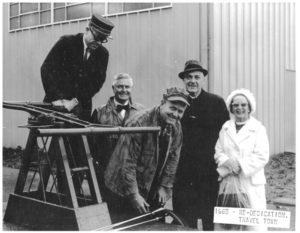Travel Town History
The text below is from a City press release that was sent out shortly after Travel Town’s founding in 1952.
Seven decades after Bill Frederickson’s wonderful idea, Travel Town is still open daily at 10:00 AM, free of charge! The Japanese “Zero” fighter plane has gone off to an air museum, but kids are still climbing in the cab of the majestic Southern Pacific 3025!
The Museum continues to thrive as a popular family destination and is still
“visited each week by hundreds of youngsters and adults who are interested in the development of transportation.”
CITY OF LOS ANGELES PRESS RELEASE – 1952
Travel Town, the Los Angeles City Recreation and Park Department’s unique display of vehicles representing many modes and eras of conveyances, is visited each week by hundreds of youngsters and adults who are interested in the development of transportation.
Located on a 9-acre site at 5200 Hollingsworth Drive in Griffith Park, Travel Town is open to the public daily from 10a.m. to 5 p.m. There is no admission charge. Displaying everything from a 104-ton locomotive to a one-horse shay, Travel Town offers its visitors what for most of them is the only opportunity they ever have to see and examine at close hand many different types of vehicles.
Credit for the idea which evolved into Travel Town goes to William Frederickson Jr., the city’s superintendent of recreation. It was Frederickson who, way back in 1947, was struck with the realization that thousands of youngsters had never been close enough to climb into an airplane and get a look at the pilot’s cockpit and its myriad of controls and gauges. This was at a time when the federal government was disposing of large amounts of surplus war material, so Frederickson resolved to see if it would be possible to obtain a surplus plane to be exhibited at one of Los Angeles’ municipal playgrounds. George Hjelte, general manager of the City Recreation and Park Department, and the Board of Recreation and Park Commissioners thought the idea was a good one and allocated the sum of $700 for the purchase of seven planes which were stored in the Middle West. But by the time the necessary purchase orders had been properly channeled, the aircraft were unavailable. Although officially the project was dormant for several years, Frederickson continually mulled the idea of establishing an exhibit where youngsters could actually climb aboard various vehicles.
Just a few months ago, in late September of 1952, Frederickson was able to start the project—his dream—toward reality. Enlisting the aid of Orin Wennersten, the Recreation and Park Department’s supervisor of maintenance, he set about the work of obtaining Travel Town’s first Exhibit. Wennersten assigned a member of his staff, Charles Atkins, the task of writing a letter to D.J. Russell, president of the Southern Pacific Company, in which the suggestion was made that the railroad company might be willing to donate an obsolete locomotive to the display. Russell heartily approved the donation and directed his staff to have Engine “3025” prepared for its emergence from “retirement” and its appearance as an honored exhibit at Travel Town.
 With the donation assured, Atkins’ next problem was to determine how to move the gallant, oil-burning chugger from Glendale to Travel Town. The Belyea Truck Company agreed to tackle the ticklish task and, on October 10, the unprecedented hauling job was completed as a free public service. The Belyea Truck Company has since performed several other similar assignments in aiding the development of Travel Town.
With the donation assured, Atkins’ next problem was to determine how to move the gallant, oil-burning chugger from Glendale to Travel Town. The Belyea Truck Company agreed to tackle the ticklish task and, on October 10, the unprecedented hauling job was completed as a free public service. The Belyea Truck Company has since performed several other similar assignments in aiding the development of Travel Town.
The giant locomotive and its 25 1/2 ton tender, which in their heyday pulled several “presidential specials” during campaign sweeps across the nation, now stands on a strip of track at Travel Town, and visitors may enter the engine’s cab, examine the controls, and tug the cord which clangs its big brass bell.
News about Travel town spread like wildfire, and almost immediately the display was receiving new vehicles and other exhibits in rapid, one after the other sequence. By the first of December, Travel Town had on exhibit a 44-passenger street car given by the Los Angeles Transit Lines; an historic 76-year old dray, presented by Paul J. Smith, president of the republic Van and Storage Company, a 50-year-old kerosene tank wagon, donated by Standard Oil Company of California; a colorful old circus wagon, given by the Beverly Amusement Company; Caboose No 2117, a veteran “home on wheels” for nomadic trainmen, given by the Union Pacific Railroad Company; and a one-horse shay, the gift of Knott’s Berry Farm.
To add still more charm to the transportation array, the Pacific Electric Company donated its old Sierra Vista “waiting station,” which had sheltered “big red car” commuters over a period of several decades. With that impressive slate of exhibits cleaned and polished for the occasion, Travel Town was officially dedicated on Sunday, December 14. (1952)
Since then, several new vehicles have been added to the display, including an obsolescent Japanese “zero” fighter plane which was captured on a South Pacific island during World War II; and an ancient petroleum field fire truck, which was donated by the Shell Oil Company. And still more exhibits are being planned and will take their places of honor at Travel town in the near future, according to Frederickson, whose “pet project” has blossomed into a popular attraction for Southlanders and tourists of all ages. The unique facility is particularly a “Mecca” for transportation hobbyists.


